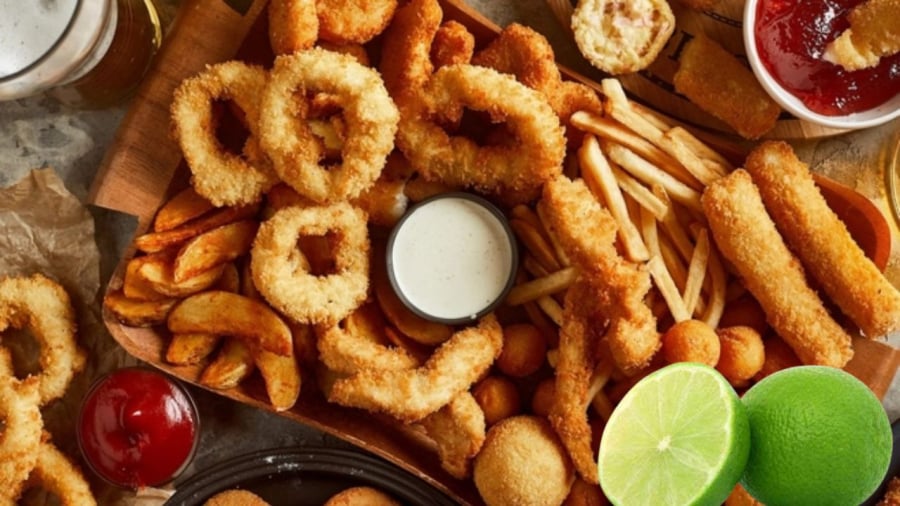The way food is prepared not only determines its taste but also directly affects its nutritional value and the eater’s health. Many seemingly harmless cooking habits can reduce the quality of meals and even produce toxins that are hazardous to the body. Here are some common food preparation mistakes to avoid for a delicious and healthy meal.
1. Deep-frying food – tempting but risky
Deep-fried foods like french fries, fried chicken, and breaded fish are always enticing with their crispy coating and distinctive flavor. However, deep-frying, especially when using oil that has been reused multiple times, can pose a significant health risk. Such dishes may contain high levels of trans fats, a leading cause of cardiovascular disease.

According to a study published in the Heart journal, regularly consuming deep-fried foods can increase the risk of cardiovascular issues by up to 28%, coronary artery disease by 22%, and heart failure by 37%. Additionally, these unhealthy fats increase “bad” LDL cholesterol while decreasing “good” HDL cholesterol, damaging blood vessels and increasing the likelihood of stroke and heart attack.
Deep-frying at high temperatures can also form toxic compounds like acrylamide, a potential carcinogen if accumulated in the body over time.
2. Overcooking or eating raw food – both are hazardous
Some people have a habit of overcooking or boiling food for extended periods, believing that “well-cooked food fills the stomach for longer.” However, this practice, especially at high temperatures, can completely destroy essential vitamins and minerals. For instance, vitamins C, B1, and B6 are easily degraded by prolonged exposure to high temperatures. Furthermore, prolonged bone broth cooking can release nitrites, precursors to nitrosamines, which are carcinogenic.

On the other hand, consuming raw or undercooked meat, fish, or inadequately washed vegetables carries the risk of parasitic and bacterial foodborne illnesses. Severe cases can lead to dangerous conditions such as liver fluke infection, gastrointestinal infections, or brain abscesses caused by parasitic invasions.
3. Using the same cutting board for raw and cooked food – a habit that can cause cross-contamination
Using the same cutting board for raw and cooked foods, such as meat and vegetables, can lead to cross-contamination, a common cause of foodborne illnesses in households. Bacteria from raw food, such as E. coli and Salmonella, can be transferred to cooked food and cause illness. To prevent this, use separate cutting boards for raw and cooked foods and maintain good hygiene by cleaning knives and cutting boards after each use.
4. Overheating oil or reusing it multiple times
Another common mistake is overheating oil until it smokes before adding food for frying. When oil is overheated, its fatty acids break down and produce toxic compounds like aldehydes and peroxides, increasing the risk of cancer and cellular damage.
Additionally, reusing frying oil multiple times alters its structure, generating free radicals that contribute to premature aging and cardiovascular damage. To ensure safety, use oil at moderate temperatures, and do not reuse oil, especially if it has changed color, developed a burnt smell, or started foaming.
5. Charred grilled food – tasty but toxic
Some people prefer their grilled meat or stir-fried dishes with a charred exterior, believing it enhances the flavor. However, this charred exterior contains harmful compounds like polycyclic aromatic hydrocarbons (PAHs) and heterocyclic amines (HCAs), both classified as potential carcinogens.
To reduce the formation of these compounds, avoid excessive heat when grilling and do not cook directly over flames. Instead, grill at moderate temperatures, turn the food regularly, and remove charred portions before consumption.
6. Reheating food multiple times – a breeding ground for toxins and bacteria
A common mistake is cooking large batches and repeatedly reheating leftovers. This practice not only diminishes the flavor but also increases the risk of bacterial growth, nutritional degradation, and toxin formation, especially in dishes like soups and stews.
It is best to cook for single meals, consume the food promptly, and, if necessary, store it properly in airtight containers, clearly labeled, and reheat it correctly for a short duration.
Tips for healthier cooking
- Prioritize steaming, boiling, and gentle stewing to retain maximum vitamins and minerals.
- Minimize deep-frying and prolonged cooking at high temperatures.
- Use fresh ingredients, store them properly, and prepare them soon after purchase.
- Avoid cooking in large batches, and if there are leftovers, ensure proper storage and early consumption.
- Read oil labels carefully and choose oils with higher smoke points if deep-frying is necessary.
Proper food preparation not only enhances the taste but also safeguards your long-term health. Let’s abandon unhealthy cooking habits and embrace a healthier approach to mealtime.
The Unassuming Culprits: 4 Everyday Items That May Be Harming Your Family’s Health
The kitchen is often the heart of a home, but it can also be a hotbed of hidden health hazards. While they may seem harmless, everyday kitchen items can pose serious risks to your well-being if used long-term. Experts are now warning about four common items in particular that could be detrimental to your health, urging homeowners to remove them from their kitchens immediately to avoid potential illnesses.






































